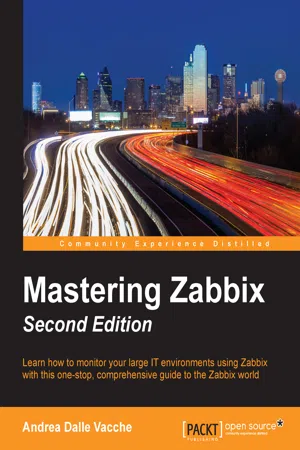
Mastering Zabbix - Second Edition
Andrea Dalle Vacche
- 412 pagine
- English
- ePUB (disponibile sull'app)
- Disponibile su iOS e Android
Mastering Zabbix - Second Edition
Andrea Dalle Vacche
Informazioni sul libro
Learn how to monitor your large IT environments using Zabbix with this one-stop, comprehensive guide to the Zabbix worldAbout This Book• Create a tailor-made monitoring solution based on your specific needs• Learn advanced techniques of Zabbix to monitor networks, performances, and other critical features in large environments• Integrate, customize, and extend your monitoring solutions with external components and softwareWho This Book Is ForThis book is intended for system administrators and IT architects who need to better integrate their Zabbix installation with their surrounding environment. A basic, working knowledge of Zabbix and Linux is assumed so that the book can focus on how to use every component to its full advantage. It will also be helpful to be familiar with programming concepts and languages but if not, all the content in the book is thorough and well documented.What You Will Learn• Efficiently collect data from a large variety of monitoring objects• Organize your data in graphs, charts, maps, and slide shows• Build intelligent triggers and alarms to monitor your network proactively• Write your own custom probes and monitoring scripts to extend Zabbix• Configure Zabbix and its database to be high available and fault-tolerant• Automate repetitive procedures using Zabbix's API• Integrate Zabbix with external systems• Understand the protocol and how to interact with it by writing your own custom agentIn DetailNowadays monitoring systems play a crucial role in any IT environment. They are extensively used to not only measure your system's performance, but also to forecast capacity issues. This is where Zabbix, one of the most popular monitoring solutions for networks and applications, comes into the picture. With an efficient monitoring system in place you'll be able to foresee when your infrastructure runs under capacity and react accordingly. Due to the critical role a monitoring system plays, it is fundamental to implement it in the best way from its initial setup. This avoids misleading, confusing, or, even worse, false alarms which can disrupt an efficient and healthy IT department.This new edition will provide you with all the knowledge you need to make strategic and practical decisions about the Zabbix monitoring system. The setup you'll do with this book will fit your environment and monitoring needs like a glove. You will be guided through the initial steps of choosing the correct size and configuration for your system, to what to monitor and how to implement your own custom monitoring component. Exporting and integrating your data with other systems is also covered.By the end of this book, you will have a tailor-made and well configured monitoring system and will understand with absolute clarity how crucial it is to your IT environment.Style and approachThis book is an easy to follow, step-by-step guide to monitoring network and performance in large environments with Zabbix. It is designed for real-world Zabbix administrators, and is comprised of a perfect mix of theoretical explanations and practical applications, making it your perfect companion.